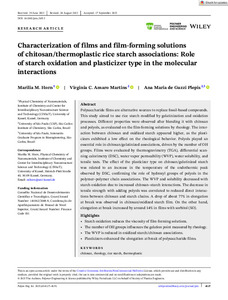| dc.date.accessioned | 2024-02-01T17:34:31Z | |
| dc.date.available | 2024-02-01T17:34:31Z | |
| dc.date.issued | 2023-09-29 | |
| dc.identifier | doi:10.17170/kobra-202312209251 | |
| dc.identifier.uri | http://hdl.handle.net/123456789/15426 | |
| dc.description.sponsorship | Gefördert im Rahmen des Projekts DEAL | ger |
| dc.language.iso | eng | |
| dc.rights | Attribution-NonCommercial-NoDerivatives 4.0 International | * |
| dc.rights.uri | http://creativecommons.org/licenses/by-nc-nd/4.0/ | * |
| dc.subject | chitosan | eng |
| dc.subject | rheology | eng |
| dc.subject | rice starch | eng |
| dc.subject | thermoplastic | eng |
| dc.subject.ddc | 540 | |
| dc.subject.ddc | 660 | |
| dc.title | Characterization of films and film-forming solutions of chitosan/thermoplastic rice starch associations: Role of starch oxidation and plasticizer type in the molecular interactions | eng |
| dc.type | Aufsatz | |
| dcterms.abstract | Polysaccharide films are alternative sources to replace fossil-based compounds. This study aimed to use rice starch modified by gelatinization and oxidation processes. Different properties were observed after blending it with chitosan and polyols, as evaluated on the film-forming solutions by rheology. The interaction between chitosan and oxidized starch appeared higher, as the plasticizers exhibited a low effect on the rheological behavior. Polyols played an essential role in chitosan/gelatinized associations, driven by the number of OH groups. Films were evaluated by thermogravimetry (TGA), differential scanning calorimetry (DSC), water vapor permeability (WVP), water solubility, and tensile tests. The effect of the plasticizer type on chitosan/gelatinized starch was related to an increase in the temperature of the endothermic peak observed by DSC, confirming the role of hydroxyl groups of polyols in the polymer–polymer chain associations. The WVP and solubility decreased with starch oxidation due to increased chitosan–starch interactions. The decrease in tensile strength with adding polyols was correlated to reduced direct interactions between chitosan and starch chains. A drop of about 77% in elongation at break was observed in chitosan/oxidized starch film. On the other hand, elongation at break increased by around 14% in films with sorbitol (SO). | eng |
| dcterms.accessRights | open access | |
| dcterms.creator | Horn, Marilia Marta | |
| dcterms.creator | Martins, Virginia da Conceição Amaro | |
| dcterms.creator | Plepis, Ana Maria de Guzzi | |
| dc.relation.doi | doi:10.1002/pen.26513 | |
| dc.relation.projectid | Grant Number: 140362/2008-8 ; Grant Number: Finance Code 001 | eng |
| dc.subject.swd | Chitosan | ger |
| dc.subject.swd | Rheologie | ger |
| dc.subject.swd | Reisstärke | ger |
| dc.subject.swd | Thermoplast | ger |
| dc.subject.swd | Physikalisch-chemische Eigenschaft | ger |
| dc.type.version | publishedVersion | |
| dcterms.source.identifier | eissn:1548-2634 | |
| dcterms.source.issue | Issue 12 | |
| dcterms.source.journal | Polymer Engineering & Science | eng |
| dcterms.source.pageinfo | 4127-4139 | |
| dcterms.source.volume | Volume 63 | |
| kup.iskup | false | |


